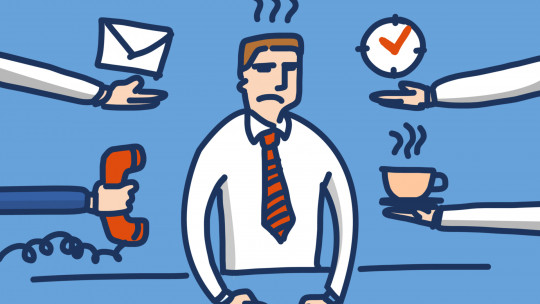What is work stress and in what types can it be expressed? We must begin this article by warning that it will be impossible to list each and every one of the causes that can make a worker feel stress, so it will necessarily be necessary to group them and, therefore, simplify the problem.
It is also essential to draw a line between what are specific stress levels and those sustained over time It is normal to experience some stress from time to time; It helps us get the job done. Here we will talk about situations of sustained stress, those that exceed the worker’s ability to feel control over the task, the work environment or his own emotions.
The appearance of work stress
Roughly speaking, A worker will feel work stress when he perceives that there is a lack of adequacy between his resources and the demands of the environment The optimal thing would be for there to be an adjustment between both, person and environment, but when this adjustment does not occur, stress situations are generated. Better said, stress will occur when the person is aware that said adjustment does not exist because either the demands or the working conditions exceed their capacity for resistance.
Excessive workload, lack of control over work, inadequate reward ambiguity in the role, a toxic boss, picky colleagues, crazy schedules, boredom, the feeling of injustice, stagnation or lack of professional development, tasks with impossible deadlines, the emotional demands of the job , one’s own capabilities…
The list can be endless and each worker may have circumstances that are a source of stress. Sometimes you won’t even be able to identify them specifically. Where do we start then?
Types of work stressors
A first way to identify stressors can be to classify them into three groups: those referring to the specific job position, those referring to the organization and the person themselves Other factors can also be included, perhaps more remote, that have more to do with the political/economic/legal/cultural framework of labor dynamics.
This “magma” on which organizations and workers themselves are based is experiencing slow but profound changes that condition many of the “precipitating” factors of stress.
Referring to the organization (poor work design or inadequate environment)
In this first category of work stressors we find, fundamentally, the following problems.
1. Role conflict and/or ambiguity
For office workers, it is one of the main stress factors associated with the job. It occurs when the worker does not really know what is expected of him or is not clear about his objectives or responsibilities. He receives contradictory orders, does not know where the limits of the task lie or by what his work is judged. Is about a typical problem in large and poorly structured organizations
2. Role overload
It is also caused by a poor distribution of work. The worker is entrusted with more responsibilities than he can assume, whether due to time, training or hierarchy. There is also “role underload”, when the worker’s capabilities are underestimated and are assigned jobs that are not in line with their training or skills.
3. Communication problems and interdepartmental conflicts
Conflict between departments due to contradictory objectives, an imbalance of power between them or poor communication.
4. Insufficient career and development plans
People aspire to improve and expect their companies to help them do so through training and professional development. If the company is not able to meet career expectations deep dissatisfaction can occur in the worker. The problem can be aggravated if the company had previously raised these expectations.
5. Organizational structure
If the company or organization is highly hierarchical, it is likely that decisions will not reach lower levels and Poor top-down communication This is a source of dissatisfaction and stress.
6. Work environment
Tension within the organization, excessive control towards workers and conflictive relationships increase stress among workers and, ultimately, can lead to extreme situations of aggression (mobbing or workplace harassment) or emotional exhaustion (burnout). Both have a lot to do with the organizational climate and culture although in the case of mobbing, the assistance of an aggressor or “bully” is also necessary.
7. The location of the company itself and its design or the services it offers to the worker
For example, a job that is far from home or the lack of services such as parking, cafeteria, etc. It can lead to lengthening the working day or having to invest free time to alleviate some of these deficiencies.
Associated with the job
In this category we find the following types of work stressors.
1. Job insecurity
Precarious and temporary work is focus of pressure and stress
2. Mental load necessary to carry out the task
If the task requires sustained attention or mental effort.
3. Control over the task
It is one of the variables most associated with work stress in many of the studies carried out. It occurs when the worker You have no control over the tasks you must perform and/or cannot organize their agenda or work content since they depend on third parties or situations outside their ability to maneuver.
4. Variety and complexity of the task
If the task is very monotonous or too complex, it will cause stress.
5. Identity and coherence of the task within the organization
The worker must know what his or her individual – or group – impact is within the context of the organization. If the worker has the feeling that her work is useless, is not visible or is dispensable will experience frustration
6. Intradepartmental relations
In the same way as interdepartmental relationships, poor relationships with close coworkers will produce stress and can lead to other more acute problems
7. Physical conditions of the workplace
Factors such as poor lighting, excessive noise, temperature, humidity, pollution, etc. would come into play here.
8. Material conditions of the workplace
Not having the right material (computers that are too slow, machinery that does not work correctly, etc.) can also generate continuous moments of stress.
9. The physical risks of the workplace
This would include all those that can cause musculoskeletal damage; long days standing without the possibility of moving or sitting, carrying weight, forced postures, handling of dangerous and/or toxic materials, rigid positions when using the computer, physical and visual fatigue, etc.
10. Shift shifts and night shifts
They carry a significant impact and disorder on a physical and psychological level
11. Remuneration for work linked to objectives
If the objectives are very high, they can cause either stress or laziness (if one is not able to achieve them).
12. Schedules, breaks and vacations
Very long hours and/or accumulation of long days for weeks not taking breaks between tasks, etc.
Related to the person
We said at the beginning that stress occurred when the person felt a mismatch between the demands of the environment and their own abilities. Therefore, the worker’s personality plays an important role when assessing the threat. Some personality traits can feed or reduce the feeling of stress and influence our coping strategies.
1. Emotional control
There are people who manage to maintain great control over their emotions and are able to adapt them to the moment and situation. Both positive and negative emotions are part of life and work. It is important to face them properly and maintain a balance neither overreacting to negative emotions nor denying them.
2. Emotional empathy
In the same way that you have to know how to manage your own emotions, it is important to recognize the emotions of others and know how to empathize with them. This will facilitate good relationships with colleagues and will ensure that the person has “social support” within the organization. Social support has been consistently linked to a lower experience of stress.
3. Ability to self-motivate
It is achieved through intrinsic motivation, the feeling that one’s work has “meaning”, the perception of self-efficacy in the assigned task and the recognition of third parties. Motivation is also a stress buffer.
4. The degree of tenacity
Understood as the ability to take responsibility, reliability, approach tasks systematically and orderly has been consistently associated with job satisfaction and lower levels of stress. However, perfectionism and the degree of self-demand towards oneself are personality traits strongly associated with the experience of stress.
5. Emotional stability
The emotional stability of the worker will greatly influence their mood and perception of stress. If the worker is going through unstable life moments in other aspects of his life, this will also affect his stress level at work.
6. Food, sleep and exercise
Leading healthy lifestyle habits increases the possibilities of stress management.
Factors related to the political and social framework
Few human realities have changed as much since the dawn of time as labor relations. Change is the norm and the magnitude of change in this area has been colossal. Not long ago people aspired to a stable job for life Nowadays this is more of a rare exception more linked to the administration than to private companies. The massive incorporation of women which began in the middle of the last century, the strength of developing economies, mainly Asian, which have profoundly modified the industrial fabric on a global scale, etc.
In the last twenty years other trends are having a strong impact on how we relate to our work and to the companies that employ us We can point out some of them:
Definitely, Jobs have become more insecure while workers are more vulnerable The level of demand has risen and social support tends to decrease. These circumstances may explain why in some industrialized countries stress has replaced muscle problems as the first cause of sick leave.









